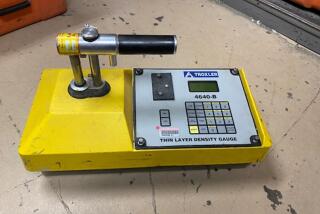The Cutting Edge: Computing / Technology / Innovation : PLOWSHARES : Hand-Held Radar Shows Contents of Walls
- Share via
How’s this for home improvement: a hand-held electronic device you simply wave against a wall to locate studs, plumbing and electrical wiring. Such a tool could be on the market next year, thanks to radar technology developed by Tom McEwan, an electronics engineer at the Lawrence Livermore National Laboratory.
The Livermore, Calif., lab has licensed the technology to Zircon Inc., a Campbell, Calif.-based producer of electronic hand tools. Zircon is working on a prototype of the device, which would sell for less than $100 in do-it-yourself retail outlets.
At the heart of the device is its ability to send out extremely fast electrical pulses--more than 1 million per second--that can travel about 20 feet through a wall. The pulses bounce off of any object behind the wall, such as a wooden stud or metal pipe, and “echo” back to the tool, displaying them on a small screen attached to the tool.
It’s a variation on standard radar, in which microwaves are used to detect aircraft and other objects over vast distances.
McEwan, who formerly worked with radar at Northrop Corp.’s defense electronics group, said the idea for the hand-held device stems from Lawrence Livermore’s weapons research. The lab had developed ways of measuring similar high-speed electrical pulses that would come from detonating nuclear weapons, he said.
The device could have many other applications besides finding studs, McEwan said. Two examples: Someone installing solar heating devices on top of a house, or laying carpet in the living room, could use the tool to easily find the joists underlying either the roof or the floor.
The battery-powered tool’s electrical pulses are invisible and safe, having a radiation-emission level 1 million times lower than a cellular telephone’s, McEwan said. Zircon isn’t the only one trying to exploit McEwan’s idea. Amerigon Inc. of Burbank licensed the technology from Lawrence Livermore with an eye toward placing radar-emitting devices on the exterior of cars, so drivers could be warned of any other vehicles--or people--behind them.
More to Read
Inside the business of entertainment
The Wide Shot brings you news, analysis and insights on everything from streaming wars to production — and what it all means for the future.
You may occasionally receive promotional content from the Los Angeles Times.









